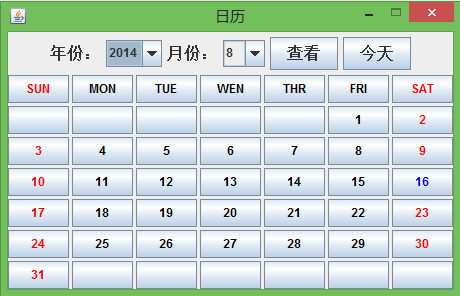在学习了张老师的(GUI)视频后,自己跟个书上的例子做了个日历
分析:
1、通过继承JFrame类,把图形日历实现一个窗口;
2、通过实现ActionListener接口是的窗口本身能处理用户单击窗口中按钮的事件;
3、使用下拉列表框JComboBox存放年份和月份;
4、通过JButton实现"查看"和“今天”按钮,addListener方法为按钮注册时间处理器是,当按钮被单击时,由事件处理器响应;
5、用一个面板JPanel显示日期信息,面板中放多个按钮,每个按钮代表一个日期;
6、日期面板中的界面布局使用GridLayout(网格布局管理器),把面板分成多个规则的网格,将日期按钮顺序放在网格上;
7、窗口的界面布局使用BorderLayout(边界布局管理器),将窗口分成南、北、东、西和中5个方向,将组件放在窗口上;
8、使用Java.util.GregorianCalendar类计算日期、星期和闰月。
代码:
(代码有点多,不好意思漏了好多注释,大家包涵啦)
import java.awt.BorderLayout;
import java.awt.Color;
import java.awt.Font;
import java.awt.GridLayout;
import java.awt.event.ActionEvent;
import java.awt.event.ActionListener;
import java.util.Date;
import java.util.GregorianCalendar;
import javax.swing.JButton;
import javax.swing.JComboBox;
import javax.swing.JFrame;
import javax.swing.JLabel;
import javax.swing.JPanel;
public class CalendarTrain extends JFrame implements ActionListener{
//月份和年份下拉 列表框
private JComboBox MonthBox = new JComboBox();
private JComboBox YearBox = new JComboBox();
//年份月份标签
private JLabel YearLabel = new JLabel("年份:");
private JLabel MonthLabel = new JLabel("月份:");
//确定和今天按钮
private JButton button_ok = new JButton("查看");
private JButton button_today = new JButton("今天");
//获取今天的日期、年份和月份
private Date now_date = new Date();
private int now_year = now_date.getYear() + 1900;
private int now_month = now_date.getMonth();
private boolean todayFlag = false;
//用一组按钮显示日期,一共7行7列。第一行是星期
private JButton[] button_day = new JButton[42];
private final String[] week = {"SUN","MON","TUE","WEN","THR","FRI","SAT"};
private JButton[] button_week = new JButton[7];
private String year_int = null;
private int month_int;
/*构造函数*/
public CalendarTrain(){
super();
this.setTitle("日历");
this.init();
this.setLocation(500, 300);
this.setResizable(false);
pack();
}
//初始化日历
private void init() {
Font font = new Font("Dialog",Font.BOLD,16);
YearLabel.setFont(font);
MonthLabel.setFont(font);
button_ok.setFont(font);
button_today.setFont(font);
//过去20年--未来20年
for(int i = now_year - 20;i <= now_year + 100;i++){
YearBox.addItem(i+"");
}
YearBox.setSelectedIndex(20);
for(int i = 1;i <= 13;i++){
MonthBox.addItem(i+"");
}
MonthBox.setSelectedIndex(now_month);
//放置下拉列表框和控制按钮的面板
JPanel panel_ym = new JPanel();
panel_ym.add(YearLabel);
panel_ym.add(YearBox);
panel_ym.add(MonthLabel);
panel_ym.add(MonthBox);
panel_ym.add(button_ok);
panel_ym.add(button_today);
//为两个按钮添加时间监听器
button_ok.addActionListener(this);
button_today.addActionListener(this);
JPanel panel_day = new JPanel();
//7*7
panel_day.setLayout(new GridLayout(7, 7, 3, 3));
for(int i = 0; i < 7; i++) {
button_week[i] = new JButton(" ");
button_week[i].setText(week[i]);
button_week[i].setForeground(Color.black);
panel_day.add(button_week[i]);
}
button_week[0].setForeground(Color.red);
button_week[6].setForeground(Color.red);
for(int i = 0; i < 42;i++){
button_day[i] = new JButton(" ");
panel_day.add(button_day[i]);
}
this.paintDay();//显示当前日期
JPanel panel_main = new JPanel();
panel_main.setLayout(new BorderLayout());
panel_main.add(panel_day,BorderLayout.SOUTH);
panel_main.add(panel_ym,BorderLayout.NORTH);
getContentPane().add(panel_main);
}
private void paintDay() {
if(todayFlag){
year_int = now_year +"";
month_int = now_month;
}else{
year_int = YearBox.getSelectedItem().toString();
month_int = MonthBox.getSelectedIndex();
}
int year_sel = Integer.parseInt(year_int) - 1900;
Date firstDay = new Date(year_sel, month_int, 1);
GregorianCalendar cal = new GregorianCalendar();
cal.setTime(firstDay);
int days = 0;
int day_week = 0;
if(month_int == 0||month_int == 2||month_int == 4||month_int == 6
||month_int == 7||month_int == 9||month_int == 11){
days = 31;
}else if(month_int == 3||month_int == 5||month_int == 8||month_int == 10){
days = 30;
}else{
if(cal.isLeapYear(year_sel)){
days = 29;
}else{
days = 28;
}
}
day_week = firstDay.getDay();
int count = 1;
for(int i = day_week;i<day_week+days;count++,i++){
if(i%7 == 0||(i+1)%7 == 0){
if((i == day_week+now_date.getDate()-1)&& month_int==now_month && (year_sel == now_year-1900)){
button_day[i].setForeground(Color.BLUE);
button_day[i].setText(count+"");
}else{
button_day[i].setForeground(Color.RED);
button_day[i].setText(count+"");
}
}else{
if((i == day_week+now_date.getDate()-1)&& month_int==now_month && (year_sel == now_year-1900)){
button_day[i].setForeground(Color.BLUE);
button_day[i].setText(count+"");
}else{
button_day[i].setForeground(Color.BLACK);
button_day[i].setText(count+"");
}
}
}
if(day_week == 0){
for(int i = days;i<42;i++){
button_day[i].setText("");
}
}else{
for(int i = 0;i<day_week;i++){
button_day[i].setText("");
}
for(int i=day_week+days;i<42;i++){
button_day[i].setText("");
}
}
}
@Override
public void actionPerformed(ActionEvent e) {
if(e.getSource()==button_ok){
todayFlag=false;
this.paintDay();
}else if(e.getSource()==button_today){
todayFlag=true;
YearBox.setSelectedIndex(20);
MonthBox.setSelectedIndex(now_month);
this.paintDay();
}
}
public static void main(String[] args) {
CalendarTrain ct = new CalendarTrain();
ct.setDefaultCloseOperation(JFrame.EXIT_ON_CLOSE);
ct.setVisible(true);
}
}























 166
166











 被折叠的 条评论
为什么被折叠?
被折叠的 条评论
为什么被折叠?








